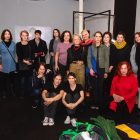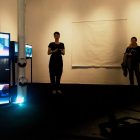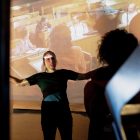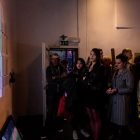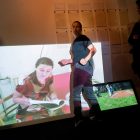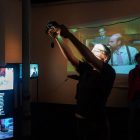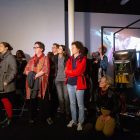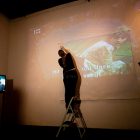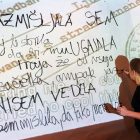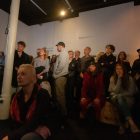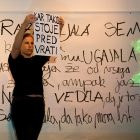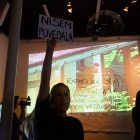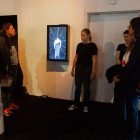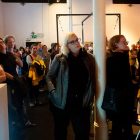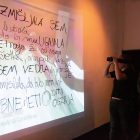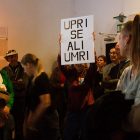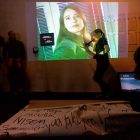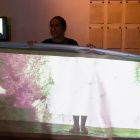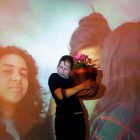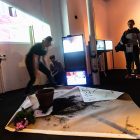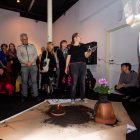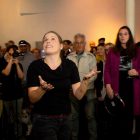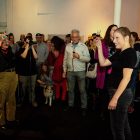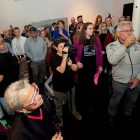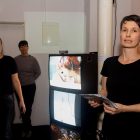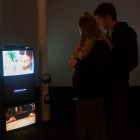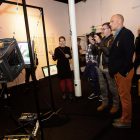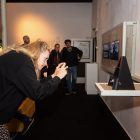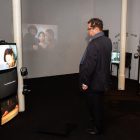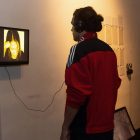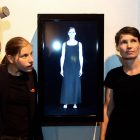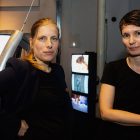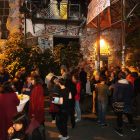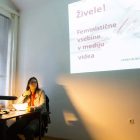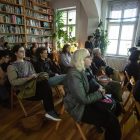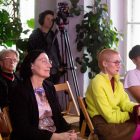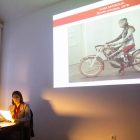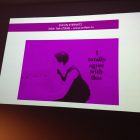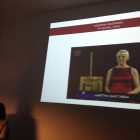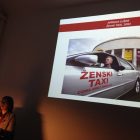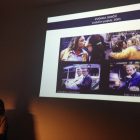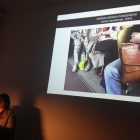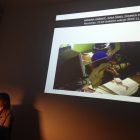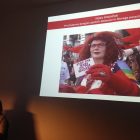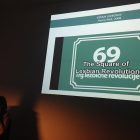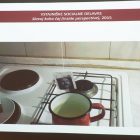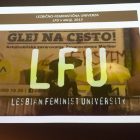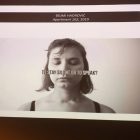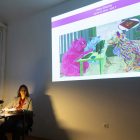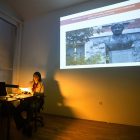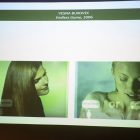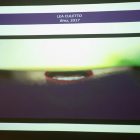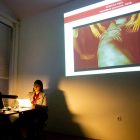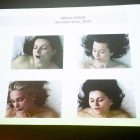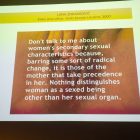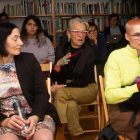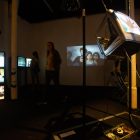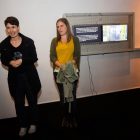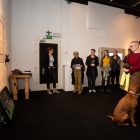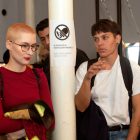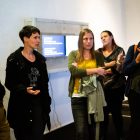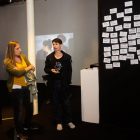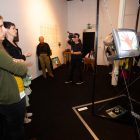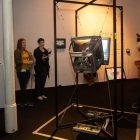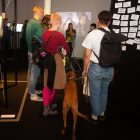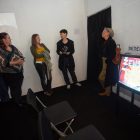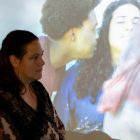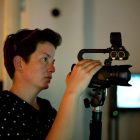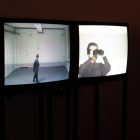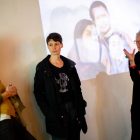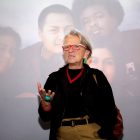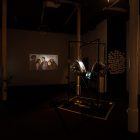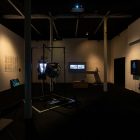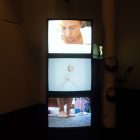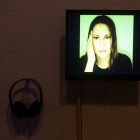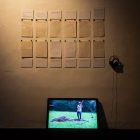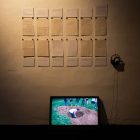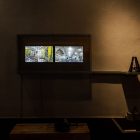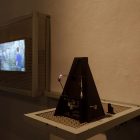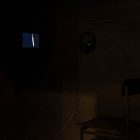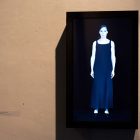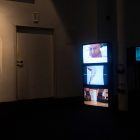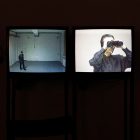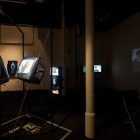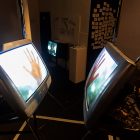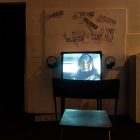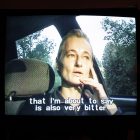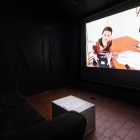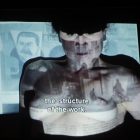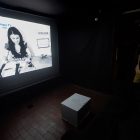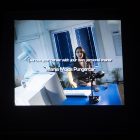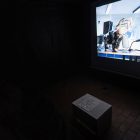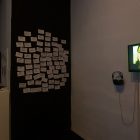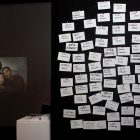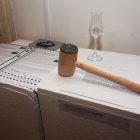25th International Festival of Contemporary Arts – City of Women
Cheers to Women! 25 Years of Film and Video
Group exhibition
24 September – 7 October 2019
Alkatraz Gallery, AKC Metelkova, Ljubljana
Opening and performance by Ana Čigon: Tuesday, 24 September 2019 at 7pm
Artists: Zemira Alajbegović & Neven Korda,* Nika Autor,* Vesna Bukovec,* Jasmina Cibic,* Ana Čigon,* Andreja Džakušič, Ana Grobler, Marina Gržinić & Aina Šmid, Đejmi Hadrović, Maja Hodošček, Sanela Jahić, Neža Knez, Polonca Lovšin,* Aprilija Lužar, Nika Oblak & Primož Novak, Ana Pečar & Oliver Ressler, Nataša Prosenc Stearns, Marija Mojca Pungerčar, Pila Rusjan, Duba Sambolec, Zvonka T Simčič, Nataša Skušek, Metka Zupanič, Valerie Wolf Gang
Curators: Vesna Bukovec and Ana Čigon
*The works of these authors are going to be screened at the Cheers to Women! 25 Years of Film and Video marathon in Slovenian Cinematheque on 3 October.
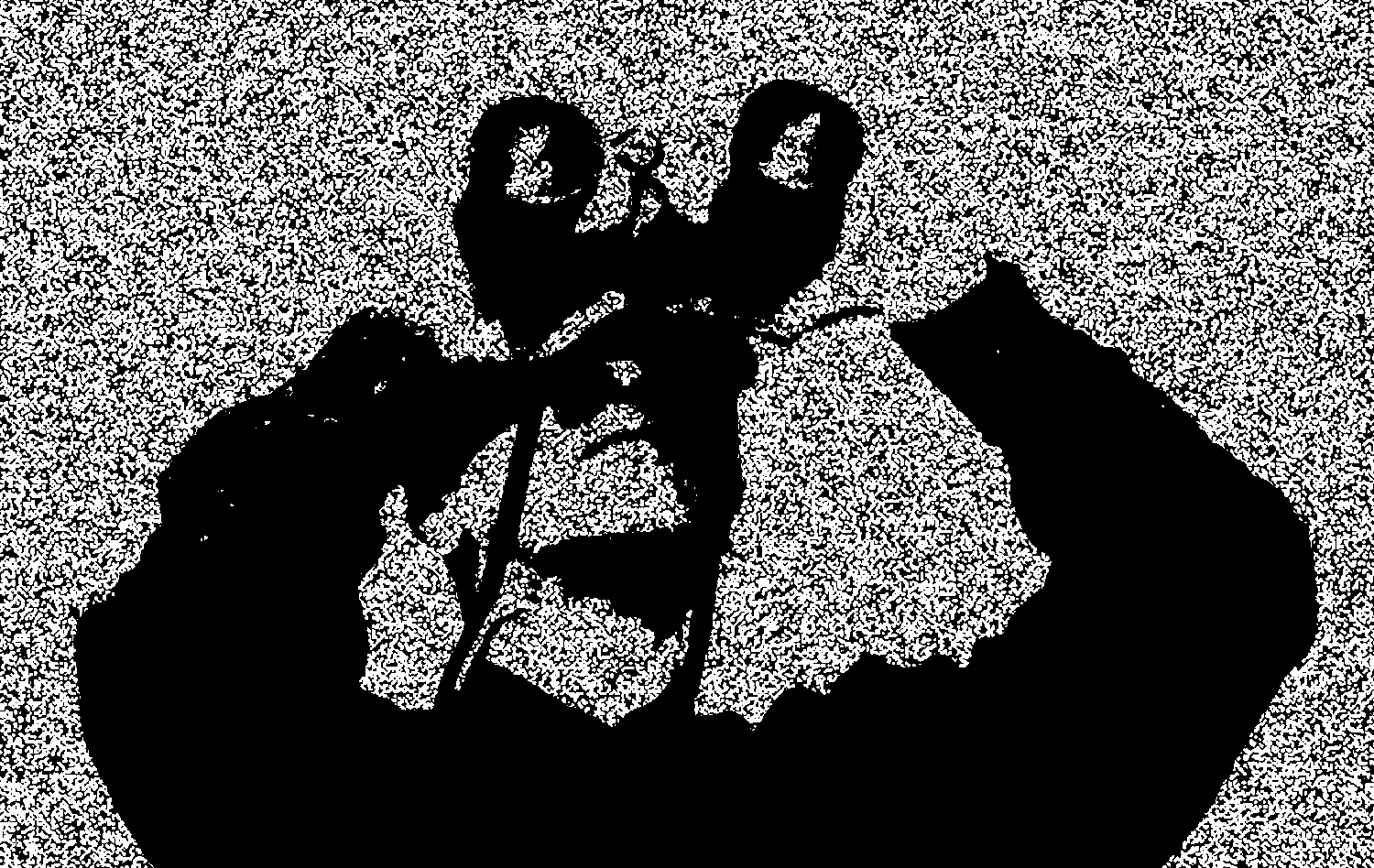
International festival of Contemporary Arts – City of Women is celebrating 25th anniversary. SCCA-Ljubljana together with video and new media archive DIVA Station joins the festival as a partner organisation. Artists Ana Čigon and Vesna Bukovec, as well a DIVA Station co-worker, curated a group exhibition Cheers to Women! 25 years of Film and Video with emphasis on female video artists active in the last 25 years. In their search for the authors, the curators analysed the video archive DIVA Station and looked through the former editions of the City of Women festival.
The exhibition will be opened on Tuesday, 24th September at 7 pm by a new performance by Ana Čigon Cheers to Women! A Performative Appetizer to Video Art, dedicated to video art created between 1995 and 2015 by Slovenian female videasts. Through the eclectic merging of written, spoken and performative quotes, the artist is forming a performative tale, encouraging viewers to an in-depth viewing of the exhibited works. In that sense, the performance is formed as an experimental historical overview, otherwise different from the classical critical texts, but nevertheless awakening the video archives, contemporizing it and thereby encouraging a re-thinking of the meaning and position of artwork by Slovenian female video artists within the canon of art history.
The public programme includes guided tours of the exhibition and a lecture by artist and curator Ana Grobler, MA who has been researching feminist art in Slovenia for more than a decade. At her lecture, she is going to present the key art works with feminist content that have been created in the area since the mid-1970s. She is going to focus on art works that use the medium of video and are connected to the Cheers to Women! exhibition in Alkatraz Gallery. Her lecture is also going to touch upon the social context in which this engaged art form is being developed in – and continues to be inseparably connected to.
Alkatraz Gallery opening hours during the City of Women festival:
Mon-Thu: 11am – 7pm
Fri: 3pm – 11pm
Sat 28 Sept & 5 Oct: 3pm – 11pm
Sun 29 Sept & Sun 6 Oct: 3pm – 11pm
Invitation card (pdf)
Exhibition info (pdf)
Cheers to Women! 25 Years of Film and Video exhibition catalogue (pdf)
- Cheers to Women! 25 years of Film and Video (curatorial text)
- Selected Works
- Artists’ CVs
- Public Programme
- Photo & Video Gallery
- Colophon
Cheers to Women! 25 Years of Film and Video
Upon the jubilee edition of the City of Women festival, we – the undersigned and Varja Močnik, who selected the female film directors – were assigned the honorable task of preparing an overview and selection of works by female video artists active in Slovenian space in the period of the past 25 years, since the beginning of the festival. The idea for the review of video- and film production was formed as a tribute to the first two marathons in 1997 and 200, organized within the City of Women festival by film director Maja Weiss. That was the first comprehensive screening of productions by female film artists in the history of Slovenian film. It left a bitter taste, however, since it was only in 2002 that we got the first feature film by a female director (Guardian of the Frontier by Maja Weiss) was released. Meanwhile, video art shows an entirely different picture, since Ana Nuša Dragan (in tandem with Srečo Dragan) was the pioneer of video art in our area.
Already 19 years have passed since the last marathon, so it is high time for another overview and research. We have taken on the demanding task by starting to set limits, since it is impossible, given the space and finances at hand, to present a precise overview and listing of all female authors and the entire production. We have agreed on a symbolic number 25: 25 female authors creating for the past 25 years, to be presented at the 25th festival edition. In our search for the authors, we analysed the video archive DIVA Station at the SCCA-Ljubljana and looked through the former editions of the City of Women festival. We have focused on those who create video and film within the wider field of visual arts. Our selection is, of course, subjective and reflects our preferences to the works showcasing feminist and socially critical content, created after 1995.
The selected artwork features examples of diverse exhibition forms enabled by the video medium. Most works are presented in gallery space using single-channel, multi-channel or installation setups on different media. Some of the works will be screened in a cinema hall as part of the Marathon: Cheers to Women! 25 Years of Film and Video in Kinoteka on 3 October between noon and midnight. By screening their films in their regular programme, even the national broadcaster RTV Slovenia is to pay tribute to Slovenian female directors.
An important part of the exhibition in the Alkatraz Gallery, also available online, is the project Open Register of Female Creators [1]. Thus, we are also including, by name at least, all female authors not displaying their work in the exhibition. We are inviting visitors to add missing names to the list to help compose and supplement an overview of creators once or still active in this geographical space in the field of video, film, animation or intermedia art (where the video medium also plays an important role).
What do all 25 works presented in our selection have in common? The answer is complex but somehow akin to the open form of feminist thought, constantly verifying the foundation of its assumptions and adapting its objectives and criticism given the current social, economic and political conditions. We were interested in how culture, economic-social regime and politics directly influence the lives of women and people in general. In their works, some female authors tackle the topics of social, economic (class) and political position of women usually ranking in the public sphere, while other female authors reach into the private sphere in their works. The issues of gender and reproductive rights, the female body, pain and violence against women are the topics the authors disclose, represent and thereby make visible in the public space. They direct attention towards silenced topics and discriminated social groups, and they expose the absence of a critical perspective at the current social and political events. Those topics are rarely represented in the media. The exposure of these problems is perhaps often a motive of their creativity also due to the fact that the recognition of many important women and events from the past, especially those that were relevant for the “other half”, was frequently concealed from history.
Established artist Duba Sambolec discusses exactly that in her two-channel video Shadowless A and B (2000) – gaps in the media space. And it is quite scary that her questions: “What really happened? What is going on?” make us wonder whether this video wasn’t perhaps filmed yesterday. How many banal news are being presented to us daily as something relevant, and how many actually important information is withheld? A human being with binoculars around her neck constantly craves information, but with her eyes blindfolded and her repeating plead for explanation and guidance, she seems a grotesque image of the present time.
However, knowledge- and information transfer does not only belong in the domain of the media. It is, first and foremost, tackled by schools that transfer knowledge dictated by the ruling ideology to youth by selecting their learning content. If it seemed, in the former political system, that ideology was too embedded in school, and that school is ideologically neutral today, Maja Hodošček shows otherwise with her video Učna ura (The Lesson, 2017). The Partisan school system topic, no longer part of the regular learning curriculum, thereby remaining part of the forsaken history, was proposed to the teacher by the artist herself. In the background, we can follow the discussion on the meaning of education in the radical conditions during the National Liberation Movement of the WWII and the relationship between the teacher and the kids. The author frames shots exclusively on those pupils that are uninterested in the conversation. The silent, passive majority of the class thus reflects today’s wider society, where people mostly deal with their own problems.
The once ideologically biased form of the newsreel is proficiently used to pierce through the media silence by Nika Autor, a member of the Newsreel Front (Obzorniška Fronta) with Newsreel 63 – The Train of Shadows (2017). The film form of the newsreel which was informing the audience of the current events in pre-television times is actualized by the author to be used as a socially critical reflection on the humanitarian tragedy of the refugees in Europe. Through film history, she seeks space for representation – to outline an image of those that have no right to an image. In her animation Okrožnica (Circular, 2016), Vesna Bukovec further discusses the image of Slovenia and Europe; their relation towards the period when larger groups of refugees were arriving; and directs attention towards the most important thing from the humanitarian viewpoint. After the media has bombarded us (they still do) with information on the number of people crossing our border (by which they, of course, speak of the so-called unwanted foreigners, not our neighbours to the North and West), the amount of money spent for this (although we spent it mostly for the police, the army, the shameful cutting wire and the panel fences), and explanations of how the migrants endanger us, the Okrožnica animation reminds us of the values that matter from the humane viewpoint, encouraging solidarity instead of fear.
So, how are the media, school and the topic of refugees connected to feminism? In many ways. The society does not construct the identity of an individual, male or female, simply based on their sex/gender (which is, in itself, a social construct), but also on other aspects, such as class, nationality, sexual orientation and identity, religion, etc. A woman can at the same time be a refugee, Muslim, a lesbian, a rich Westerner or Eastern European, middle-class, etc. Any of these parameters can affect her reality differently. In feminism, this is called intersectionality and is commented in the work Silent Observer (2017) by Đejmi Hadrović. Although we don’t see her most of the time, this work is essentially one of the most frequent feminist art forms – a self-portrait. However, it is not a romantic portrait of an ingenious artist that would disclose the origins of her creative force. The author does not talk about when in her youth she first picked up a pencil, but instead about how she was defined by the world. The self-portrait is placed within a social and political context: we see her presentation in the form of a mirror, showing a critical reflection of viewership – the society – through defining personal circumstances. Simultaneously, the author plays with us by returning the gaze – she gives a misleading presentation of her job, discloses its precarious nature and hardships. However, only at the end are we to realise she is not talking about the job of a prostitute, but an artist, instead.
The question of the economic position of the female artist, tackled in Hadrović’s video, is upgraded and supplemented by Andreja Džakušič. In the Survival Tactics (2011), we hear the experiences of Slovenian and international artists about the ways of survival in connection to artistic practise, recognized by everyone as a precarious form of work. In the existing art system, their work is unappreciated, does not provide social security, is usually underpaid, all too often unpaid. Džakušič discusses the lowliness, indecency and humiliation in this line of work, when everyone involved in the process of preparing an exhibition can get paid – except for the artists. They remain down, at the bottom. In the video, we therefore cannot see any faces, only feet and shoes of the speakers, and in the background, the outlines of their flats and studios.
Most Slovenian artists exhibit in institutions funded by state or city. As Džakušič already points out, this fact unfortunately doesn’t vouch for a just approach towards their work, but besides the financial starvation, the production co-financed by the state can also meet other types of pressure. In her work Fruits of our Land (2013), Jasmina Cibic discloses the state’s interests in the financing of art projects. Through her reconstruction of a parliamentary debate from 1957 on which works would be most suitable and representative for the décor of the newly built parliament building, Cibic shows that numerous factors are at work in drawing decisions on large representative projects. In this instance, art is shown to be a polygon for the battle of interests regarding the construction of a national identity in line with the current ruling political option, simultaneously under the impact of such banal parameters as the limited time scope for the availability of decision-makers and keeping the politician’s conscience clear when they hurry their selection, acceptable to almost no one.
More contemporary trouble in the art world is discussed in the work by a younger generation artist Valerie Wolf Gang. Due to scarce working conditions, young artists often turn to artistic residencies, which are of course welcome, especially for those interested in travelling and working abroad. However, they do have their down sides. This lifestyle also has a considerable impact on our personal life and partnerships, which is what Valerie Wolf Gang addresses in her installation Sorry, I can’t make it today (2018).
Of course, the position of artists should also be investigated in the wider sense, through the critique of neoliberalism, which is a research topic of several female artists. Some works of this kind have been included in our selection, however, we will be returning to this topic later on. The installation Sorry, I can’t make it today namely also opens the issues of the private sphere and the woman’s body, both classic motives of feminist art. In her video Migraine (2007), Ana Grobler tackles the disease affecting three times as many women as it does men, asking if its frequency is rooted in biology or in society. The society and helthcare are setting the issue aside. Usually, migraines are dismissed as a nuisance to put up with, as something women should learn how to accept.
A woman’s body in connection to reproductive rights and motherhood is discussed in the videos Ekstaza (Ecstasy, 2005) by Nataša Skušek and Ad Utero Ab Ovo (2007) by Zvonka T Simčič. Whoever thinks that the regulation of reproductive rights and thereby women’s bodies in the Western world is a thing of the past is simply wrong. Even though the world population is growing rapidly and will soon surpass this planet’s capacities, the idea of decreasing birth rates is ungraspable to society. A woman is still expected to have a child, to want one. And a lot of them do. However, it is telling that our society does not wish to raise the birth rate by means of migrations. Moreover, it does not let single women conceive by artificial insemination. Zvonka T Simčič does not accept the society’s dictate. In the video, she depicts her own experience of artificial insemination, pregnancy and giving birth. She points out the hypocrisy of society (and religion) by depicting herself as the pregnant Mother Mary. But the regulation does not end there. Motherhood is publicly pictured entirely in positive terms. The negative experiences are rarely discussed. As breast-feeding is not encouraged in public spaces, we also rarely publicly discuss the pain that can be involved in it. Through a series of self-portraits during painful breast-feeding, Nataša Skušek closely films her face, thus introducing the theme of complexity of motherhood and depicting a reality she has recognized in her own experience.
A special kind of body regulation is depicted in the animation Rebellious Essence (2017). In it, the author Ana Čigon discloses the absurdity of the system of bureaucracy, denying the right to legal gender confirmation to persons that cannot or will not be defined by the binary gender division. The author transfers this problematic to the animal world in order to avoid another frustrating element in communication – language –, given that non-binary persons already face problems due to the gender bias of Slovenian language.
The limiting social frameworks of frustration, powerlessness and anger are felt by individuals of any gender. They are depicted well by Nika Oblak and Primož Novak in their installation The Scream (2015). The female artist, dressed in black in an empty dark space, performs the existential Munch’s The Scream to break the glass wall of a digital cage. Could this be the “hysterical” scream aiming to break the glass ceiling? On the opposite site of The Scream is the work For-nothing (2016) by Neža Knez. Both works contain a humorous gesture of the absurd, unproductive act, causing a fracture or a hole. The title For-nothing (when read aloud the Slovene title Za-nič could be understood as ‘for nothing’ and ‘worthless’ simultaneously) encompasses two meanings, essential to the creation and reception of art works, namely the issues of artistic intention and the quality of the work. Through the physical work of digging a hole, the author also establishes the connection to the economic value of the work, which is precarious in art, as shown already by Andreja Džakušič. Neža Knez dug a hole in the lawn, then filled it again. The act left physical traces in the space and triggered a reflection on the creation of an artwork. The work is composed of the video documentation of the action and the selection of statements written about the meaning of this action by random passers-by.
Zemira Alajbegović takes on the private sphere from entirely different inclinations. The painful documentary Med štirimi stenami (Within Four Walls, 1999) she directed together with Neven Korda features statements by brave women who temporarily sought refuge from their violent partners in safe houses, and portrays the flaws of Slovenian judicial system and welfare that fail to provide true protection to the abused. At this point we are returning to the visibility and disclosure of taboo themes on which the female video artists shed light. Thus, violence, rape, trade in girls and women, homo- and lesbophobia, paedophilia and the escape route from violence are also discussed by the portrayed women in an international project by Aprilija Lužar Ženski Taxi – Govoreči portreti (Women’s Taxi – Talking Portraits, 2002–2006). In her taxi, the author managed to create a safe space to face the trauma of individual women, for whom this was the first time to publicly speak out.
The private sphere is also the focus of a documentary video by Pila Rusjan Elisa, 5 (2010), filming the 5th birthday celebration of Elisa, living in a squatted building in São Paulo. However, her party is interrupted by a forceful eviction and consequently, the loss of her home. The video Reposition (2015) by Nataša Prosenc Stearns addresses the trouble of adolescents, regardless of gender. With her video the author returns their dignity to five members of a Californian youth programme for adolescents on the margins of society and is simultaneously paying tribute to mutual trust among them. In several attempts, the members of the group reposition and intertwine their own bodies, observing whether they feel good in the new pose/role. The video metaphorically depicts their attempts to find a new, better position in society.
In their videos, Pila Rusjan and Nataša Prosenc Stearns do not explicitly present the cause of their protagonists’ poverty, however, it is clear that the given situation is also the result of rampant capitalism which is not at all concerned by social inequality. An indirect critique of capitalism is also present in some of the aforementioned works. In her work Sanela Jahić applies a more direct critique of capitalism. In a two-channel video and kinetic object Tempo Tempo (2014), she wonders about the effects of the ever wider and faster automatization of the production process. The reason for introducing machines to the production industry is, of course, not the unburdening of the workers. The essential objective is to accelerate effectiveness and thereby increase the profits. Since we know that in capitalism, every moment is an element of profit, the machine does not adapt to the speed and movement of the worker, but vice versa. The body becomes more and more caught in the tempo of the production process. Thus, we are again returning to the regulation of bodies, this time in line with the dictate of capital. However, the results of capitalistic pushing towards profits are not only felt by the industrial workers, but also the employees in the service sector. This is abstracted by Marija Mojca Pungerčar in her work Career Fitness (1998), where she is dressed in a business suit only to demonstrate exercises to “stay in career shape”, a topic which can also be transposed into the field of artistic endeavours. Bureaucratization of the job, competitiveness, fake cheerfulness and communication skills are supposedly essential for career progress, however, in her video, the artist drives them to the absurd, disclosing mantras on personal accountability for one’s own success as a farce.
Both Jahić and Pungerčar take on certain negative effects of the capitalist system. People were most directly affected by its brutality at the time of austerity measures and the decline of the welfare state due to restricted public consumption after the crisis of 2008. Its results are still present in Europe. Criticism of American neoliberal ideas that had caused the crisis, the outrageously free market, minimal state interference, unleashed privatization and hasty increase of loans that got hundreds of thousands of Americans into a state of enormous debt, practically impossible to pay off, is commented by Ana Pečar with her co-author Oliver Ressler in the work In the Red (2014). The documentary has a special value also because it, in contrast to most of the other works, does not simply expose a certain problem, immanent to neoliberalism, but also introduces one of the solutions collectively designed by a group of protesters and implemented within the framework of the Occupy movement. The group responded to the repression of the financial markets against the indebted population of the USA through a refined system of reselling debts with solidarity and a witty action that saved a number of people from debt. The solution that the young rebels offer is simple: “Rise up or die.”
In this text, we’ve often mentioned the documentary, which seems more of a film form. The issue of difference between film and video is an old one, and divisions between them were never clearly defined. Since technology became more affordable and digital media dominates, it is even harder to discuss the differences. As the exhibition Cheers to Women! shows, art video is heterogeneous and can therefore be presented in diverse forms. It appears in single- and multi-channel forms, as a multimedia installation, as video performances or as performance documentation. Videos are often accompanied by texts and other objects. Sound could be emphasized or absent. Some works can be presented even on the big screen of a cinema hall. At the exhibition, our selection attempts to stress the formal aspect of exhibiting video art. Exploring new forms is also important because by resisting against the routine forms of film and video narrative, artworks can convey their critique of capitalism through form. This aspect of video art is questioned by internationally acclaimed video artists Marina Gržinić and Aina Šmid in the work Obsession (2008). In it, the authors experiment with form and select several theoretical views to reflect on the creation of a radical knowledge, antagonising the new as well as the old colonial context of capitalism.
And Here We Are (2016), the work by Metka Zupanič could also be placed in the context of videos that consider the negative effects of capitalism and larger social aftermath on people’s lives. In her video installation, the author establishes a situation of hypnosis, symbolising the indifference of people to the world arms race, which seemed to have stopped for a brief historic moment after the fall of the Berlin Wall. The greed of the military industry is the dominant reason for the aggressive spread of neoliberalism and raising new and new wars and armed conflicts, taking place far away from the western world, coming to us only as media images. The USA have the largest war budget, followed by China. Slovenia and the rest of the European states, members of the NATO, are by no means neutral in this game. Military investments are increasing, we respond to weapons with more weapons. The once important institutions for ensuring world peace, such as the UN, are rapidly losing their power and credibility, while fear and tension grow in people. The world has been under a threat of nuclear war for decades now. It could be caused by a narcissist leader or perhaps an error in the storing of nuclear weapons. After Slovenia declined its signature of the ban on nuclear weapons by the UN and after the Intermediate-Range Nuclear Forces Treaty was terminated in August, it seems like humanity has slept through this news. Hypnotized by a mantra of urgent safety precautions, we are standing still at this critical point in history.
We are closing our reflection with the honeybees, depicted by Polonca Lovšin in her video animation Back to the City (2011). In addition to the militarization of society and the potential nuclear disaster, our survival is also threatened by the climate crisis. One of the reflections of our irresponsible treatment of nature is the problem of massive bee killings due to pesticides, which can have a devastating effect on plants, animals and people. Lovšin presents the possible extinction of bees with a cheerful stop-motion animation, however, the consequences she introduces are nevertheless creepy. Similar to the video by Ana Pečar and Oliver Ressler, this work also provides an answer – care for the bees, seeking space for them. If we have transformed the environment through intensive farming to the degree that the bees can no longer live in it, we are obliged to find a space for them to survive, otherwise their extinction will also be our own.
Moreover, we are closing with the honeybees because they can provide a good example for us, as well. They namely work and survive exclusively as a community. Saving a single bee is impossible. The entire hive must survive, or they all die out. The solution for the future of humankind is probably the same. We have to think and act in the direction of collective survival or else face extinction. To conclude, we are returning to the critical thought from the videos Shadowless A and B. The solution does not lie in asking further blind and passive questions: “What is going on?” while keeping our eyes blindfolded in spite of the binoculars in our hands. Instead, the solution lies in the decision for action. Or, as the thought of resistance concludes in the video In the Red: “Rise up or die.” So, let’s throw off the blindfolds and look the truth in the eyes together.
And cheers to women!
Ana Čigon & Vesna Bukovec
—
[1] Names of various video artists that were collected at the exhibition are published as Seznam slovenskih videastk (List of Slovene female video artists) on Wikipedia.

Zemira Alajbegović & Neven Korda: Within Four Walls, 33′ 17”
Production: ZANK, VPK & TV Slovenija, 1999; director: Zemira Alajbegović, Neven A. Korda; script: Zemira Alajbegović; camera: Matjaž Mrak, Rok Sieberer; off-line editing: Matjaž Jankovič, Morena Fortuna, on-line editing: Vojko Zupanc; music: Aldo Ivančić; animation: Oliver Marčeta.
» video
The documentary problematizes violence towards women through stories of those who ran away from it and found help in shelters. With covered faces, they speak about years of abuse, violence, rape and loneliness. Film includes scenes from the shelter for women and children – victims of violence, statements from historians and anthropologists about the social dimensions of violence, scenes from Slovenian feature films and an original animation.
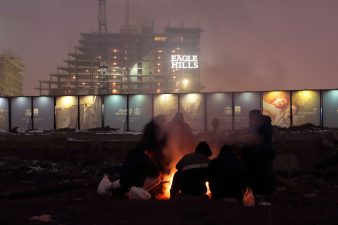
Nika Autor: Newsreel 63 – The Train of Shadows, 39’
Production: MSUM+ / KGLU, 2017; editing: Nika Autor, Ciril Oberstar; music: Matevž Kolenc, Miha Šajina; voice: Pia Nikolič; translation: Maja Lovrenov.
» video (excerpt)
Newsreel 63 follows newsreel-related practices and tries to position and understand a particular image – a shred of video taken on the once famous Belgrade–Ljubljana rail-line, where refugees now travel not in couchettes but between the train’s wheels. Newsreel 63 drifts into a visual investigation of railways and explores its historical, social and political narrative.
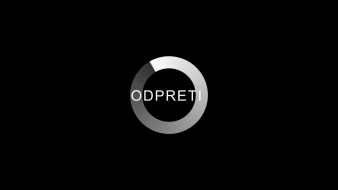
Vesna Bukovec: Circular, 3’ 40’’
Production: Vesna Bukovec, 2016
» video
A simple animation of a spinning circle informs the user that a certain process is taking place in the background even though the result is not yet visible. Inside the rotating circle, the words starting with the letter O (in Slovenian language) are appearing and disappearing. These at first sight random words turn out to be related to the life choices and situations of refugees and asylum seekers who are waiting for their application for international protection to be processed. Will their endless circle of waiting ever stop?
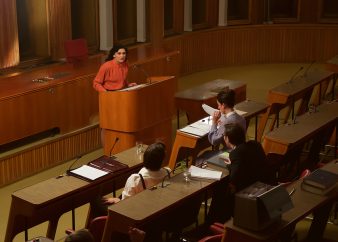
Jasmina Cibic: Fruits of our Land, 11’ 43’’
Production: MGML / Galerija Škuc, 2013; director: Jasmina Cibic; director of photography: Mark Carey; script: edited from the transcripts of the parliamentary debate of the Committee for the review of artistic works, 1957; actors: Daša Doberšek, Gregor Gruden, Branko Jordan, Marko Mandić, Pia Zemljič, Grega Zorc; editor: Michelle Deignan; music: Filip Sijanec; sound: Pip Norton.
» video (excerpt)
The film was shot specifically for For our Economy and Culture, Jasmina Cibic’s project for the Slovenian Pavilion at the 55th Venice Biennial that explored issues around national representation and its framing. The film presents a recreation of a 1957 parliamentary debate set up to decide which artworks might be suitable (i.e. nationally representative enough) to ‘decorate’ the newly built People’s Assembly. It dramatizes the power paradigms inherent in the systems of authority as well as the contradictions present in the transmutation of a national identity from past to present, place to place.
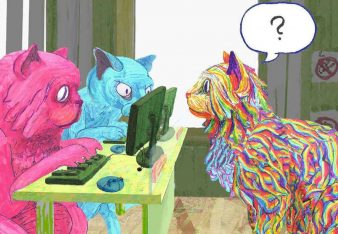
Ana Čigon: Rebellious Essence, 5’
Production: Ana Čigon and City Art Gallery of Ljubljana, 2017; script, animation, editing and voices: Ana Čigon; music: Vasja Progar.
» video
How a brave cat fights bureaucracy or the story of a cat who walks into the Office for Cat Affairs and requests for a passport. All goes pretty well until the female and male cat clerks demand to know the cat’s sex.
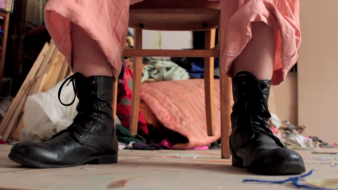
Andreja Džakušič: Survival Tactics, 42’ 40’’
Production: Andreja Džakušič, 2011
» video
The video was created for A Look at the Visual Arts in Slovenia 6, an exhibition of Slovenian contemporary art made in collaboration with nine Slovenian galleries. New production was expected from the selected artists but no funds for production were provided. The exhibition’s theme was defined with the title Me, Here, Now. The artist collected statements from ten local and foreign artists, involved in her work environment. She interviewed them about their strategies of economic survival.
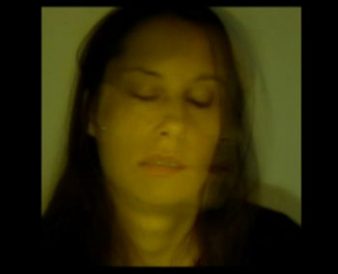
Ana Grobler: Migraine, 5’ 23’’
Production: Ana Grobler, 2007
» video
A migraine self-portrait of the artist. The entire video, from filming to montage, was made during a migraine seizure. Camera is static, video- and audio effects are made to present the state of a person suffering from it. The work focuses on the question whether a larger number of women hurting from migraines compared to men is caused by social or biological predispositions. In the ages between 35 and 40, the ratio of the sufferers is three women to one man, but in childhood the occurrence is equal in both sexes.
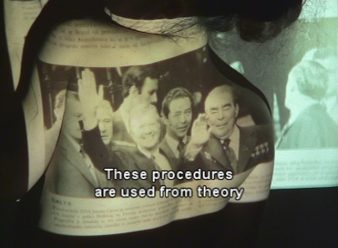
Marina Gržinić & Aina Šmid: Obsession, 16’ 10’’
Production: Marina Gržinić & Aina Šmid in cooperation with Zavod CCC, Ljubljana and the Institut de Cultura de Barcelona, 2008; written and directed by: Marina Gržinić, Aina Šmid; text in the video written by Marina Gržinić; performer: Barbara Kukovec; video made in collaboration with Zvonka Simčič.
» video
Obsession reflects on emancipative politics and the possibility of a production of radical knowledge that is opposing the new and old colonial context of capitalism. Inspired by the knowledge and resistance of Walter Mignolo, Šefik Tatlić, Ana Vujanović and Alain Badiou, the video constructs a conceptual genealogy of video art and its experimental history in the East of Europe, needed due to the changes in video digital production and reworked critical art history vocabularies.
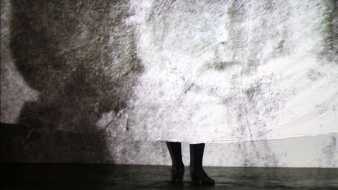
Đejmi Hadrović: Silent Observer, 9’ 12’’
Production: KulturKontakt Austria, 2017
» video
The video performance shows a monologue confession of a woman in her early thirties and the obstacles she is dealing with. The content deals with issues such as gender, identity, migration, and ethnicity. The video performance is not merely personal; it is sharing common threads of everyday world and appeals to the public to identify with the performer.
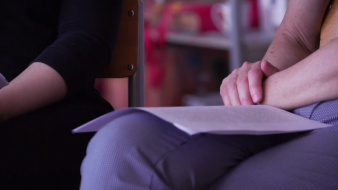
Maja Hodošček: The Lesson, 15’
Production: Maja Hodošček, 2017
» video (excerpt)
The Lesson takes places during a high school lesson. We see pupils engaged in a conversation about a particular historical movement, partisan schooling, that emerged during the Second World War in Slovenia as an opposition to the occupation. The theme was proposed by the artist who asks the students to read a letter, written by a partisan teacher, while focusing her camera’s eye on the silent figures, the pupils who remain quiet. But their silence is anything but still …
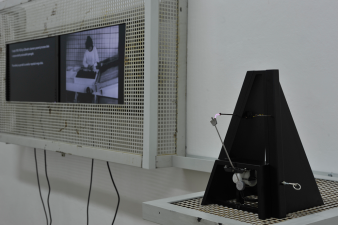
Sanela Jahić: Tempo Tempo
Double channel video and a kinetic object
Production: Sanela Jahić, 2014
By combining historical and contemporary materials, statistical data and private statements, the visual and the acoustic, Tempo Tempo conveys a narrative on accelerating the production process and enhancing work performance in order to increase competitiveness and improve profits. The video contains archival footage by Frank Bunker Gilbreth, a pioneer of time and motion study, and contemporary footage from a factory where workers talk about the consequences of robotisation. Their statements are complemented with statistical data.
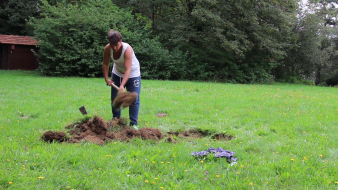
Neža Knez: For-nothing
Video 25′ 27″, texts, photos, book
Production: Neža Knez, 2016
» video
“I was on a transitional meadow full of passers by and I dug into the soil there. As soon as the material physically stopped me, I decided to fill the hole back up. People asked questions about it and I answered: This is just a hole. When the action was ‘done’, I invited seventeen people to answer one question: ‘What do you think about this?’ The work is strange, unplaceable, it produces a scar in everyday life, thoughts beyond its own, and even if there is no form, it exists just like documentation of a thought – memory.”
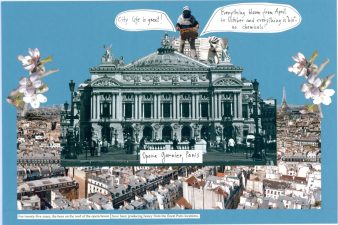
Polonca Lovšin: Back to the City, 13’ 35’’
Production: Kud Obrat, 2011; sound: Bojan Brajkovič; voice: Matija Vastl; English translation: Rawley Grau.
» video
“A few years ago, when bees began dying in large numbers in Slovenia, a story about a beekeeper in the city of Kranj caught my attention: he had harvested more honey than his friend in the countryside. This was the beginning of my research on bees, which in fact is not so much about bees as it is about human relationship to nature, food, the city, and the countryside. Focusing mainly on nature in the city and in the countryside, it questions, in particular, our established conceptions about rural and urban nature.”
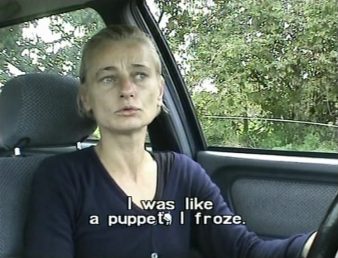
Aprilija Lužar: Women’s Taxi – Talking Portraits, 66’
Fragments from an eight-hour video installation
Production: Aprilija Lužar, 2002–2006
Women’s Taxi comprises actions, installations, video portraits, performances and paintings. Confessing in a taxi, a public mobile unit, is a metaphor for Aprilija Lužar’s art. Her work is a “confession” of personal distress that she publicly introduces and thereby socially materialises. The personal and the public overlap and become one for a moment. By using subtle performative tools, she speaks about how violence against women is not passé, but instead, is a reality to which we need to react and change it.
More about the project Women’s Taxi at City of Women archive.
TAXIART exhibition leaflet from PM Gallery, Zagreb, 2006 (pdf)
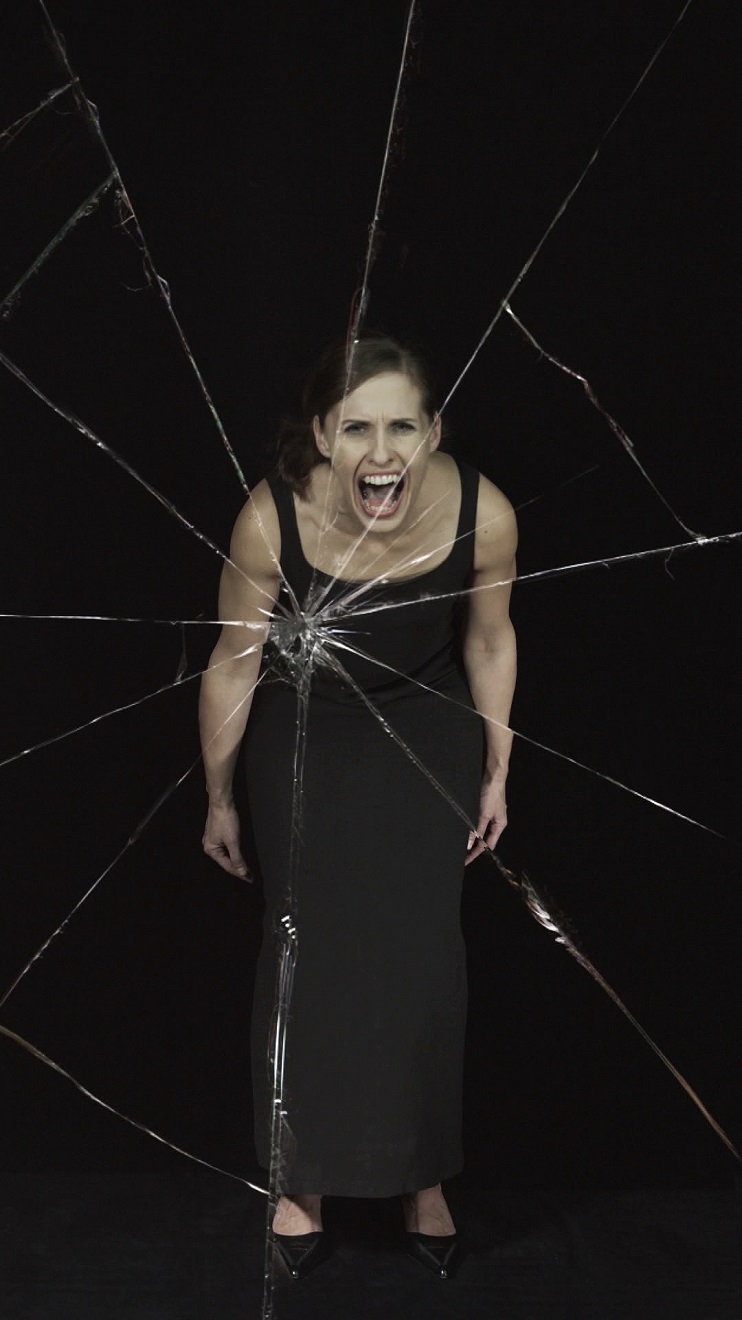
Nika Oblak & Primož Novak: The Scream
Video installation
Coproduction: Soulangh Artist Village, Tainan, Taiwan, 2015
Video installation The Scream is inspired by Edward Munch’s painting The Scream. It shows the performer in deep concentration who then screams out with full force. Her powerful voice breaks the screen.
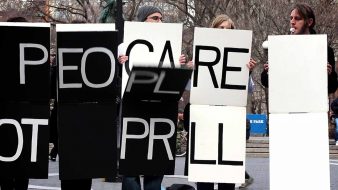
Ana Pečar & Oliver Ressler: In the Red, 20’
Production: Ana Pečar & Oliver Ressler, 2014; directed by: Ana Pečar & Oliver Ressler.
» video
In the Red is a film about the Strike Debt organisation dealing with debt, one of the key themes of our era. Strike Debt initiates activities to expose hidden mechanisms of financial capitalism. For very little money, the Rolling Jubilee group buys the huge amounts of personal debt the banks have already written off; they then strike off the debts and therefore free the debtors from their bills.
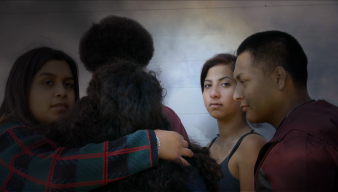
Nataša Prosenc Stearns: Reposition, 3’ 42’’
Production: Kanalya Pictures, 2015
» video
Reposition is a group video portrait of five members involved in Venice Youth Build, a program providing education and job training to out-of-school and out-of-work youth in California to help them reposition into successful adulthoods. The video was produced in partnership with the Mirror Mirror Project, which is establishing collaborations between artists and homeless youth.
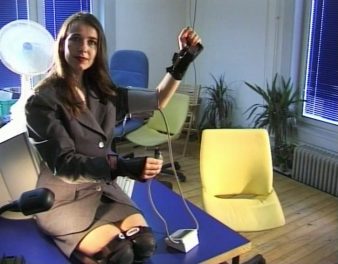
Marija Mojca Pungerčar: Career Fitness, 37’ 43’’
Production: Marija Mojca Pungerčar, 1998
Video Career Fitness includes a slightly visionary, but also humorous distance towards careerism, with which the author expresses her position of an Eastern-European artist conquering the West. This is going on at the end of the 1990s, when analogue media are being gradually digitalized. In the video, the author, playing the role of a business woman, demonstrates exercises to keep in shape career-wise.
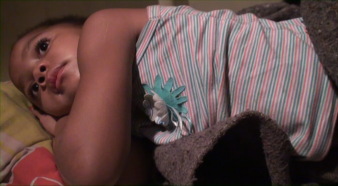
Pila Rusjan: Elisa, 5, 5’ 41’’
Production: Pila Rusjan, 2010
» video
Elisa, 5 is a video about a girl who ends up on a street on her 5th birthday, about the reality of São Paulo, the problem of homelessness, and about the social differences in the world. The 24-hour ultimatum, in which over a thousand people are forced to leave an occupied building in the middle of the city, is being intertwined with a birthday celebration of only one of the numerous children – inhabitants of that building. The video was produced during Rusjan’s Traffic Jam #1 residency in São Paulo, Brasil.
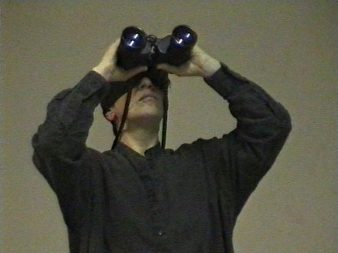
Duba Sambolec: Shadowless A & Shadowless B
2-channel video, 21’ 4’’ in 21’ 5’’
Production: Duba Sambolec, 2000
» video Shadowless A
» video Shadowless B
In search of the hidden and invisible. What doesn’t exist doesn’t have a shadow.
The information age of media is characterised by the fact that the dominant media never informs the general public of key facts that are crucial for the understanding of any situation or subject matter since certain information goes against their corporate interests or against the interests of the politics they guard and defend. The mainstream media mainly emits information that propagates the ideology of their choice. However, the missing information is crucial for critical insights and our understanding of the situation. Consequently, we become blind, and such blindness is the precondition for the domination of those in power. The videos art part of NoHomeVideos© video performance series.
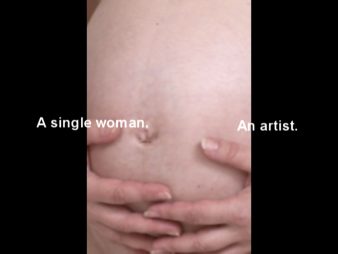
Zvonka T Simčič: Ad Utero Ab Ovo, 5’
Production: Zavod CCC, 2007
» video
Zvonka T Simčič is one of the few female visual artists whose works address the topic of motherhood in an extremely engaged manner. She critically addresses the (non)possibility of artificial insemination of single women by posing as the pregnant Virgin Mary and presenting her own experience of insemination, pregnancy, and child birth in a country that does not allow for artificial insemination of women who do not live in a union with a man.
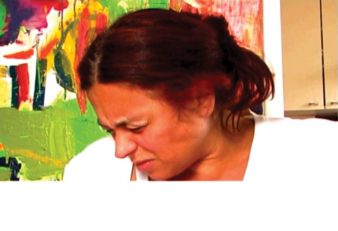
Nataša Skušek: Ekstaza [Ecstasy], 11’ 28’’
Production: Nataša Skušek, 2005
» video
“The video is composed of ten video portraits of my face while I am breast-feeding my daughter (the breast-feeding was very hard and painful for me due to mastitis).”
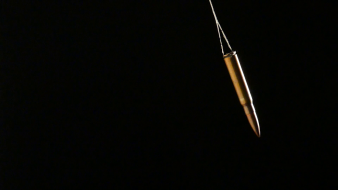
Metka Zupanič: And Here We Are
Video installation
Production: Metka Zupanič, 2016
» video
The project And Here We Are tackles the problematics of the army safeguarding/ controlling an individual and the impact of army structures on people’s everyday lives. It problematizes the ever more military society generating latent tensions, fear and hatred in people’s everyday lives.
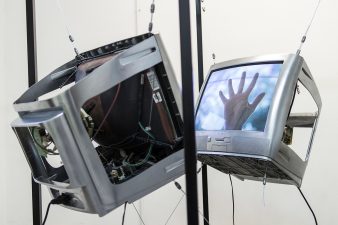
Valerie Wolf Gang: Sorry, I can’t make it today
Video Installation
Production: Valerie Wolf Gang, 2018
Sorry, I can’t make it today is an intimate art piece about the lifestyle of a professional artist. Because of her artistic practice, she is often challenged with an unusual working schedule, international travels, artist-in-residence programs and other activities, which make it difficult to organize her personal life and balance it with her career.
Zemira Alajbegović Pečovnik was, during the 1980s, a leading member of the multimedia and theatre group FV 112/15 and the FV Disko, as well as the co-founder of the video production FV Video and FV Založba publishing house. Between 1983 and 1989, she was a member of the notorious electro musical group Borghesia. In cooperation with Neven Korda, she is the author of several video films, music and dance videos. In the past years, she has been directing documentary films and TV shows on art and culture.
More at DIVA Station.
—
Nika Autor finished her studies at the Academy of Fine Arts in Ljubljana (BA and MA) and finished her PhD in Practice at the Academy of Fine Arts Vienna. Her practice is primarily based on experimental videos, film-photography essays and spatial video installations. She is part of the collective Newsreel Front (Obzorniška Fronta).
www.autor.si
—
Vesna Bukovec graduated and completed her MFA from the Academy of Fine Arts and Design in Ljubljana. She works independently and in the art group KOLEKTIVA (with Metka Zupanič and Lada Cerar). She presented her work in several solo shows in Slovenia and numerous international exhibitions. She also works in the field of graphic design and as a curator of video art. She is a co-worker at the SCCA-Ljubljana’s video art archive DIVA Station.
www.vesna-bukovec.net
—
Jasmina Cibic is a London-based artist who works in performance, installation and film, employing a range of activity, media and theatrical tactics to redefine or reconsider a specific ideological formation and its framing devices such as art and architecture. Her work draws a parallel between the construction of national culture and its use value for political aims, encouraging the viewer to consider the timelessness of psychological and soft power mechanisms that authoritarian structures utilise in their own reinsertion and reinvention.
jasminacibic.org
—
Ana Čigon creates in video, performance and film. Her projects tackle social and feminist topics, such as the underrepresentation of women artists in art history, memory and public monuments, invisible social groups, LGBTIQ+ themes, critique of neoliberalism, etc. Her works often contain elements of humour, irony and satire. Over the recent years, she has also been interested in documentary films and animation.
www.anacigon.si
—
Andreja Džakušič graduated at the Academy of Fine Arts in Ljubljana, where she also completed her master’s degree. She furthered her studies at the Vysoká škola výtvarných umení (Academy of Fine Arts and Design) in Bratislava, Slovakia, and the Akademia Sztuk Pięknych (Academy of Fine Arts) in Krakow, Poland. In 2004, she was artist in residence in Belfast. She is involved in socially engaged art and art in public space. She lives and works in Celje.
More at DIVA Station.
—
Ana Grobler has obtained an MA at the Ljubljana-based Academy of Fine Arts and a diploma from the Painting Department on the topic of Feminist Art in Slovenia. She also (co-)curated several acknowledged exhibitions with feminist content. She finished the World of Art School for Curators and Contemporary Art Critics (SCCA-Ljubljana). She works at KUD Mreža, where she has been leading the Alkatraz Gallery since October 2018. Furthermore, she is a member of the editorial board of the web portal spol.si and the Red Dawns collective.
More at DIVA Station.
—
Marina Gržinić and Aina Šmid have been involved in video since 1982. In their decades-long collaborative engagement, they have presented their video works and video installations in more than 100 video festivals and have received several major awards. Marina Gržinić (1958) is doctor of philosophy and works as research counsellor at the Institute of Philosophy of ZRC SAZU in Ljubljana. She is Professor at the Academy of Fine Arts Vienna, Austria. Aina Šmid (1957) is a professor of art history and the long-standing editor of the Ambient magazine.
grzinic-smid.si
—
Đejmi Hadrović is a time-based media artist, working with video, photography, performance and installation. In 2018, she was nominated for the OHO Young Visual Artist Award, and awarded with the Förderungspreise der Stadt Wien award. She has been a PhD student at the Academy of Fine Arts Vienna since 2017. In her works, Hadrović explores issues related to feminism, sexuality and gender in the post-Yugoslav space.
dejmihadrovic.si
—
Maja Hodošček is an artist, pedagogue, curator and researcher. She makes video works, installations, book projects as well as various workshops. She finished her MA at the Dutch Art Institute in Arnhem, the Netherlands. Her work was shown in numerous international exhibitions and festivals. In 2010, she won the OHO Young Visual Artist Award.
www.hodoscek.com
—
Sanela Jahić graduated in Painting from the Academy of Fine Arts and Design in Ljubljana in 2008 and completed the postgraduate MFA degree programme in Public Art and New Artistic Strategies at the Bauhaus University in Weimar in 2010. Jahić is an intermedia artist who constructs technologically supported kinetic objects and installations. In her latest production, the artist places the research of complex relations between technology and the social, individuals and their identity, directly into the context of the critique of capitalist relations of production.
sanelajahic.com
—
Neža Knez has participated in numerous solo and group exhibitions, residences and workshops in Slovenia and abroad. She has received several awards, including the UL ALUO Recognition and UL ALUO Award for exceptional student achievements, the award for an innovative approach to graphic arts, the Prešeren Student Award of the University of Ljubljana and the OHO Young Visual Artist Award. She is the recipient of a two-year residency for young artists at the Švicarija Creative Centre and in 2019/20, she will be part of the WHW Academy in Zagreb.
nezaknez.com
—
Polonca Lovšin is an architect and artist, based in Ljubljana, Slovenia. Her projects are based on participation, site-specificity and artistic research. In 2015, she completed her PhD in visual arts at the Bauhaus University in Weimar. She is interested in challenging existing social models in order to explore their alternatives.
www.lovsin.org
—
Aprilija Lužar creates within the media of painting, aquarel painting, drawing, video, performance and sound works. The style of her fine art works ranges from portrait realism to abstract postmodern painting, while her performative actions range from body art to participatory projects. She studied painting at the Fine Arts Academies in Sarajevo and Ljubljana, where she obtained a BA in 1987 and finished her painting specialisation in 1991. She has the status of a self-employed cultural worker.
More at City of Women archive.
—
Nika Oblak & Primož Novak have been working collectively since 2003. They have exhibited worldwide, in venues like the Sharjah Biennial (UAE), Japan Media Arts Festival, Tokyo (JP), Istanbul Biennial (TR) and Transmediale Berlin (DE). Oblak & Novak received numerous grants and awards, including the CYNETART Award (DE), an honorary mention at Biennale WRO (PL), White Aphroid Award by MMC KIBLA (SI) and Rihard Jakopic honorable mention (SI).
www.oblak-novak.org
—
Ana Pečar is an internationally acclaimed video- and intermedia artist. In 2016, she had two solo exhibitions, at the Kostanjevica church of the Božidar Jakac Gallery and in the Salon of the Maribor Art Gallery. She has lectured at the Bolzano University (the Debt Forum) and in 2015, also at the Social Inequality and Art Forum at the London-based College of Art. She shot the film In the Red together with the Austrian artist Oliver Ressler, known for his in-depth explorations of economic and environment problematics, as well as search for alternative economic systems.
More about A. Pečar at DIVA Station.
—
Nataša Prosenc Stearns’ work ranges from films and videos to installations. She graduated from the Academy of Fine Arts and Design in Slovenia and moved to Los Angeles on a Fulbright Grant for her MFA at California Institute of the Arts. Her work has been featured internationally in galleries, museums, collections and in numerous festivals. She exhibited twice at the Venice Biennale and is a recipient of the Prešeren Fund Award among others.
www.natasastearns.com
—
Marija Mojca Pungerčar finished her diploma in 1989 at the Ljubljana Academy of Fine Arts and got her MA in 2001 at the San Francisco Art Institute in the USA. Since 1983, she has been exhibiting her work at home and abroad. Her merits and awards, among others, also include the Rihard Jakopič Award, the Independent Film Festival Award and the Fulbright Scholarship. She is also head of the counselling office for self-employed artists, founded in 2014.
mojcapungercar.si
—
Pila Rusjan is a freelance video artist from Slovenia. She produces independent artworks, creates video for theatre, and works as an assistant director in film and television productions.
pilarusjan.wordpress.com
—
Duba Sambolec studied law and finished her MFA studies at the Academy of Fine Arts in Ljubljana in 1978. She had been teaching contemporary art for 20 years at the Fine Art Academies in Trondheim and Oslo. She realized many solo shows and participated in numerous national and international group shows. She has received several awards and grants. Her art practice includes multimedia installation, sculpture, drawing, collage, video/photo performance and digital photo collage.
More at DIVA Station.
—
Zvonka T Simčič is an intermedia and video artist living in Slovenia. All of her works are strongly connected to the social space she inhabits. In her new media works, she becomes a “live” actor – a performer. In 2001, she founded the CrossCommunityCreation Institute for the production of contemporary art and social research projects. For the last five years, she has been developing the House on the Hill project, where she explores contemporary art in connection with cultural and natural heritage.
www.zavod-ccc.org
—
Nataša Skušek is a visual artist. She studied sculpture at the Ljubljana Academy of Fine Arts and continued her studies at the Academy of Fine Arts Trondheim in Norway. She does sculpturing, video, photography, graphics, performance and design. For the past six years, she has also been writing short stories. In her works, she explores the relations between the genders, erotics, sex, the body, motherhood, family, and food.
More at DIVA Station.
—
As an artist, Metka Zupanič takes part in continuous, several-year projects. She has presented them at numerous international exhibitions. Since 2002, she has also been active in the art group KOLEKTIVA (together with Vesna Bukovec and Lada Cerar). As a curator, she prepares the video programme Video in Progress in the scope of the Month of Photography festival organised by the Photon Gallery.
metkazupanic.weebly.com
—
Valerie Wolf Gang is a Slovenian intermedia artist, videographer, director and lecturer. She often collaborates with international art collectives. She is the founder of UV Arthouse which produces experimental films, video installations and research in the field of new media technology and interactive multimedia works. She is preparing a PhD in the field of augmented reality and is a professional associate at the Institute for Fine Arts Vienna.
valeriewolfgang.com
Thursday, 26 September 2019
6 pm: Ana Grobler: Cheers to Women!
Lecture on feminist videoart in Slovenian
Project Room SCCA, Metelkova 6
7 pm: Guided tour in Slovenian
Alkatraz Gallery
—
Saturday, 5 October 2019
7 pm: Reprise of Ana Čigon’s performance Cheers to Women! A Performative Appetizer to Video Art in English
7.30 pm: Guided tour in English
Alkatraz Gallery
PHOTO GALLERY
Photo: Nada Žgank
Performance Cheers to Women! A Performative Appetizer to Video Art by Ana Čigon end exhibition opening
24 September 2019
Lecture by Ana Grobler Cheers to Women!
26 September 2019, Project Room SCCA / photo: Nada Žgank and SCCA-Ljubljana archive
Guided tour
26 September 2019
Exhibition View
VIDEO GALLERY
Video: Urša Bonelli Potokar
Co-production: SCCA-Ljubljana/DIVA Station, KUD Mreža/Alkatraz Gallery, City of Women – Association for the Promotion of Women in Culture
Curatorial text by: Ana Čigon and Vesna Bukovec
CVs: artists
Text editor: Tea Hvala
English translation: Jedrt Lapuh Maležič
Slovenian and English language editing: Sonja Benčina
Supported by: Ljubljana Municipality, Department for culture, Ministry of Culture of Republic of Slovenia
Acknowledgements: Museum of Modern Art Ljubljana/+MSUM (Tomaž Kučer), CONA Institute, Miha Zupan, Katerina Mirović (Forum Ljubljana), Danijela Zajc

